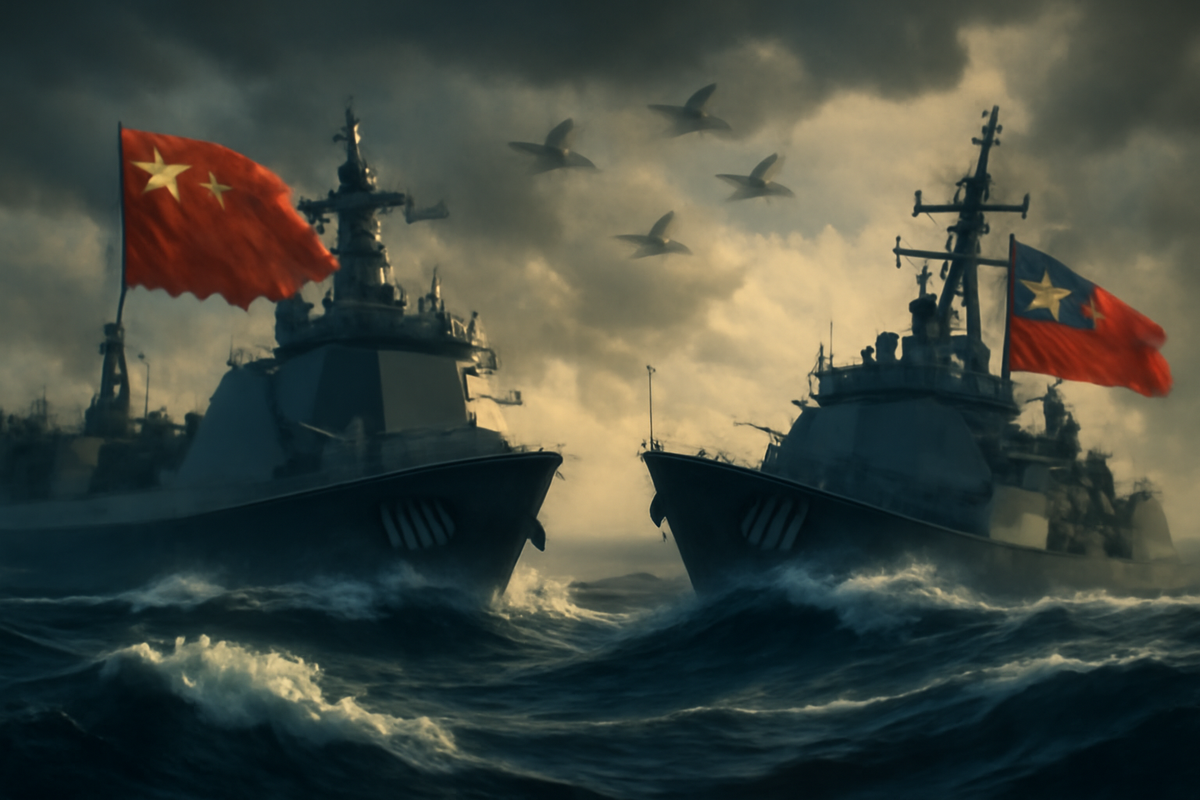Taiwan Strait Tensions Escalate: What the Latest Naval Standoff Means for Global Trade
Tensions in the Taiwan Strait have escalated after a dangerous naval standoff, threatening global shipping routes, semiconductor supplies, and energy markets. The high-stakes confrontation underscores the waterway’s critical role in trade and geopolitics.

A Flashpoint Reignited
The Taiwan Strait a narrow but strategically critical waterway separating Taiwan from mainland China has long been one of the most sensitive geopolitical hotspots in the world. But over the past week, tensions have flared to levels unseen in years, triggered by a sudden naval standoff that has sent ripples through global markets, security circles, and diplomatic backchannels.
The incident began when multiple Chinese naval vessels and coast guard ships maneuvered aggressively near Taiwan’s territorial waters, prompting an immediate response from Taiwan’s navy. For hours, the strait saw a dangerous dance of warships, with radar locks, loudspeaker warnings, and aerial overflights raising the stakes.
This was no ordinary posturing it came at a time when the region is already jittery due to U.S.-China strategic rivalry, renewed debates over Taiwan’s sovereignty, and fears of supply chain disruptions. The world was reminded, yet again, that a miscalculation here could trigger consequences far beyond East Asia.
Why the Taiwan Strait Matters More Than Ever
Geographically, the Taiwan Strait might appear as just a sliver of blue on a world map, roughly 180 kilometers across at its narrowest point. But its significance is enormous economically, politically, and militarily.

- Global Shipping Artery: Nearly half of the world’s container fleet passes through this waterway. Blockage or prolonged tension here could choke global trade routes.
- Semiconductor Lifeline: Taiwan is home to the world’s most advanced chipmakers. Any disruption here would send shockwaves through industries from smartphones to electric vehicles.
- Military Flashpoint: It is one of the few places where the navies of two rival great powers the U.S. and China operate in close quarters under constant tension.
In essence, the Taiwan Strait is not just a local issue it’s a global chokepoint where economics and geopolitics collide.
The Escalation Timeline
Day 1: The Trigger
Early morning, satellite imagery and maritime tracking systems picked up unusual movement a surge in Chinese naval activity east of Fujian province. Taiwan’s defense ministry issued a standard alert, but by mid-afternoon, Chinese warships had moved dangerously close to Taiwan’s contiguous zone, triggering a defensive response.
Day 2: The Standoff
Taiwan deployed two frigates and several fast-attack missile boats. Across the strait, China’s navy escalated with additional destroyers and an aircraft carrier presence. Aircraft from both sides flew sorties in overlapping identification zones, prompting concerns of accidental collisions.
Day 3: Diplomatic Frenzy
The U.S., Japan, and Australia issued statements urging restraint. Global oil prices rose 4% in a single day as shipping companies began rerouting cargo vessels. Stock markets across Asia dipped.
Reading the Signals Behind the Show of Force
While military maneuvers in the Taiwan Strait are not new, analysts say this episode feels different more calculated, more symbolic, and more connected to broader strategic shifts.
- China Testing Boundaries:
Beijing appears to be probing how far it can push Taiwan without triggering direct military intervention from the U.S. This fits into a broader pattern of “gray zone” tactics constant pressure without crossing the threshold into outright conflict. - Taiwan’s Defiance:
Far from backing down, Taiwan’s navy and air force responded with precision, signaling both capability and political will. For Taiwan, projecting resilience is as much for domestic morale as it is for international allies. - Message to the World:
Both sides understand that every maneuver is watched globally. The strait is not just a military zone; it’s a stage where national narratives are broadcast in real-time.
Global Trade on Edge
When a crisis brews in the Taiwan Strait, boardrooms from Silicon Valley to Stuttgart take notice. The implications go far beyond regional security they threaten the lifeblood of the global economy.

Shipping Disruptions
The strait is part of the “main artery” for goods moving between East Asia and markets in Europe, the U.S., and beyond. Even short-term tension forces shipping companies to consider longer routes through the Philippine Sea, adding days to delivery times and millions in extra fuel costs.
Semiconductor Supply Shock
Taiwan Semiconductor Manufacturing Company (TSMC) and other chipmakers supply over 60% of the world’s advanced chips. Any risk to their operations even perceived sends tremors through industries reliant on high-tech components. Already, electronics manufacturers are reviewing contingency plans.
Energy Price Volatility
Oil tankers also pass through nearby shipping lanes. The recent standoff saw a noticeable spike in Brent crude prices, as traders factored in the risk of maritime disruption in the Asia-Pacific corridor.
The U.S. Factor: Silent but Present
The United States, bound by the Taiwan Relations Act, has long committed to assisting Taiwan in maintaining its self-defense capabilities. While Washington refrains from stating it would directly intervene in every scenario, the U.S. Navy’s presence in the region is constant and unmistakable.
In this latest flare-up, U.S. reconnaissance aircraft were observed in international airspace near the strait. While no American warships entered the immediate zone of tension, their availability in nearby waters sends a deterrent signal to Beijing.
Washington’s dilemma remains balancing deterrence without provocation — ensuring China knows the costs of aggression, while avoiding steps that could make conflict more likely.
The Bigger Picture: Economic Decoupling Meets Military Signaling
This standoff is not occurring in a vacuum. It comes at a time when:
- U.S.-China trade relations are strained with new tariffs and tech export controls.
- Global supply chains are being restructured to reduce dependence on single points of failure.
- Military budgets in the Indo-Pacific are surging in response to China’s expanding naval capabilities.
The Taiwan Strait is where these economic and military currents intersect. Each side is aware that even if no shots are fired, the perception of instability can have profound economic consequences.
Potential Scenarios Going Forward
- Managed De-escalation
Behind closed doors, intermediaries may help both sides step back without losing face. Naval forces might reduce proximity operations, and trade routes resume normal flow within weeks. - Prolonged Tense Patrols
Both navies remain in close quarters for weeks, creating a semi-permanent state of high alert. This scenario keeps markets nervous and insurance costs for shipping elevated.
Accidental Collision or Incident
A miscalculation such as a ship collision or an aerial encounter gone wrong could trigger a sudden escalation, forcing immediate international mediation.

Why the World Can’t Afford a Taiwan Strait Crisis
Globalization has made the Taiwan Strait everyone’s business. It’s not just about Taiwan’s democracy or China’s territorial claims it’s about whether the world’s manufacturing backbone, digital infrastructure, and trade flows can remain stable.
A disruption here doesn’t just affect the shipping industry it ricochets into inflation, energy markets, tech innovation, and even the daily prices consumers see on shelves.
Final Word: A Delicate Balance on Choppy Waters
The latest naval standoff is a stark reminder of how quickly geopolitical flashpoints can threaten global stability. The Taiwan Strait, for all its beauty and cultural history, remains a chessboard where the world’s great powers test each other’s resolve.
For now, cooler heads may prevail. But the waterway will remain a nerve center and any ripple here has the potential to become a wave that travels across the world.
Whether this episode becomes just another entry in the long history of Taiwan Strait tensions or the opening chapter of a deeper crisis will depend on decisions made in Beijing, Taipei, Washington, and beyond.
Sources:
Official & Government Statements
- Taiwan Ministry of National Defense press releases
- Chinese Ministry of Foreign Affairs briefings
- U.S. Department of Defense statements on Indo-Pacific operations
Maritime & Defense Tracking
- MarineTraffic or VesselFinder for ship movement data
- Satellite imagery from platforms like Maxar Technologies
- Defense analysis from CSIS (Center for Strategic and International Studies) or IISS




